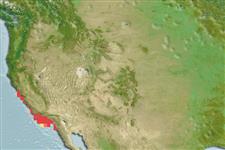>
Ovalentaria/misc (Various families in series Ovalentaria) >
Embiotocidae (Surfperches)
Etymology: Amphistichus: Greek, amphi = on both sides + Greek, stix, -ichos = row (Ref. 45335).
More on author: Agassiz.
Environment: milieu / climate zone / depth range / distribution range
Ecologia
marino demersale; distribuzione batimetrica 0 - 73 m (Ref. 96339). Subtropical; 38°N - 32°N, 123°W - 117°W
Eastern Pacific: Bodega Bay in northern California, USA to northern central Baja California, Mexico.
Size / Peso / Age
Maturity: Lm ? range ? - ? cm
Max length : 43.0 cm TL maschio/sesso non determinato; (Ref. 2850); common length : 30.0 cm TL maschio/sesso non determinato; (Ref. 2850); peso massimo pubblicato: 2.0 kg (Ref. 2850); Età massima riportata: 9 anni (Ref. 56049)
Mostly found in surf of sand beaches, but reported from trawl catches at depths up to 73 m. Also occur near rocks, pilings and other sources of cover and food. Usually form small groups. Also caught from piers and skiffs. Feed preferably on sand crabs but also eats clams and other invertebrates. Viviparous, female carries the developing young (Ref. 205). Minimum depth range based on ecology (Ref. 96339).
Life cycle and mating behavior
Maturità | Riproduzione | Deposizione | Uova | Fecundity | Larve
Viviparous, female carries the developing young (Ref. 205).
Eschmeyer, W.N., E.S. Herald and H. Hammann, 1983. A field guide to Pacific coast fishes of North America. Boston (MA, USA): Houghton Mifflin Company. xii+336 p. (Ref. 2850)
IUCN Red List Status (Ref. 130435: Version 2024-1)
Threat to humans
Harmless
Human uses
Pesca: scarso interesse commerciale; Pesce da pesca sportiva: si
Strumenti
Special reports
Download XML
Fonti Internet
Estimates based on models
Preferred temperature (Ref.
123201): 9.7 - 15.6, mean 12.9 °C (based on 12 cells).
Phylogenetic diversity index (Ref.
82804): PD
50 = 0.6250 [Uniqueness, from 0.5 = low to 2.0 = high].
Bayesian length-weight: a=0.01318 (0.00547 - 0.03178), b=3.05 (2.84 - 3.26), in cm total length, based on LWR estimates for this (Sub)family-body shape (Ref.
93245).
Trophic level (Ref.
69278): 3.5 ±0.0 se; based on diet studies.
Generation time: 7.5 ( na - na) years. Estimated as median ln(3)/K based on 2
growth studies.
Resilienza (Ref.
120179): Medio, tempo minimo di raddoppiamento della popolazione 1.4 - 4.4 anni (K=0.15-0.18; tm=2; tmax=9; Fec=113).
Fishing Vulnerability (Ref.
59153): Moderate to high vulnerability (53 of 100).
